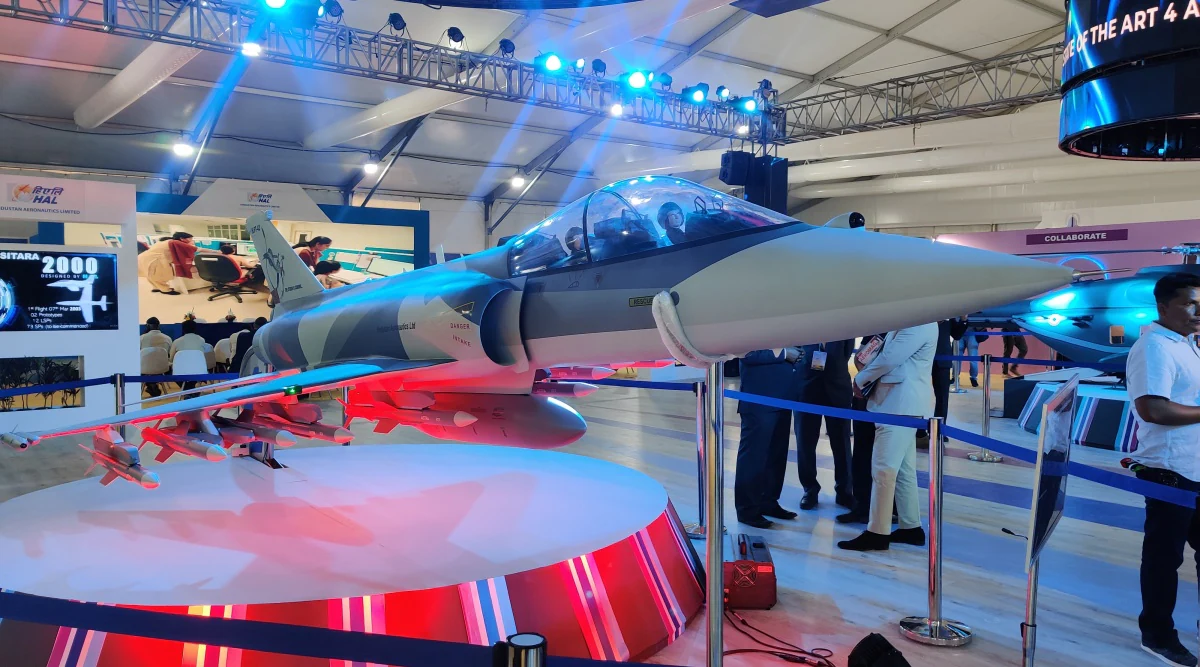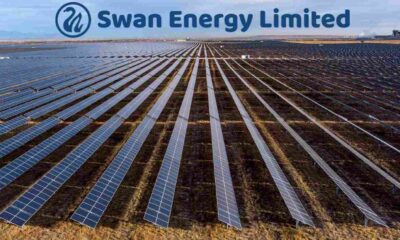defense
HAL Share Price Target 2025: Motilal Oswal Sees 27% Upside for Hindustan Aeronautics

India’s defense manufacturing sector is in the spotlight—and Hindustan Aeronautics Ltd (HAL) is taking center stage. In its latest coverage, leading brokerage Motilal Oswal has given HAL a BUY rating with a price target of Rs5,100, suggesting a 27% upside from its current market price (CMP) of Rs4,031 (as of April 2025).
This ambitious target isn’t just a number. It reflects HAL’s strong fundamentals, expanding order book, and India’s strategic push for defense indigenization.
Further speaking, let’s dive into what’s fueling this optimism.
📦 Strong Order Book = Revenue Visibility
One of the most compelling reasons behind the bullish outlook is HAL’s massive order book of Rs1.8 trillion (as of March 31, 2025). This provides clear revenue visibility for the next 3+ years, with upcoming contracts across multiple aircraft and helicopter platforms.
🔧 Recent Major Orders Include:
- Rs135B for 12 Su-30 MKI aircraft
- Rs260B for 240 AL-31FP engines
- Rs630B for 156 LCH ‘Prachand’ attack helicopters
- Rs52B for 100 RD-33 engines
- Rs29B for 25 Dornier aircraft
This robust order book is expected to ramp up HAL’s manufacturing segment significantly from FY26 onwards.
🛩️ Tejas Mk1A: The Key Near-Term Trigger
The Tejas Mk1A fighter jet program is a critical growth engine for HAL. The Indian Air Force (IAF) has already ordered 83 units of the Tejas Mk1A, and an additional 97 aircraft (worth Rs650B) are in the proposal stage, contingent on timely engine supplies from GE Aerospace.
📆 Timeline:
- Engine deliveries from GE expected to start in FY26
- Aircraft deliveries to commence thereafter
- Expansion of HAL’s Nashik facility will aid faster production and integration
Motilal Oswal sees this as a key catalyst for re-rating the stock upward in the near term.
🌐 Shift from Licensed to Indigenous Manufacturing
HAL is actively transitioning from a licensed manufacturer to an indigenous defense OEM, aligning with the Aatmanirbhar Bharat initiative.
Key Platforms Now Fully Indigenous:
- Light Combat Aircraft (Tejas)
- Basic Trainer Aircraft (HTT-40)
- Dornier-228
- Light Utility Helicopter (LUH)
- Naval Utility Helicopter (NUH)
HAL is also expanding its vendor ecosystem through SMEs and private partners, including Tata Advanced Systems, L&T, and BEL.
This shift boosts profitability, self-reliance, and export potential—three pillars of long-term valuation growth.
📈 Financial Projections (FY25–FY27)
| Metric | FY25E | FY26E | FY27E | CAGR (FY25–27) |
|---|---|---|---|---|
| Revenue (₹B) | 303.9 | 401.6 | 503.6 | 29% |
| EBITDA (₹B) | 78.8 | 110.1 | 138.9 | 33% |
| PAT (₹B) | 62.5 | 84.6 | 104.1 | 29% |
| EPS (₹) | 93.5 | 126.5 | 155.7 | — |
| RoE (%) | 18.9 | 21.8 | 22.5 | — |
💰 Valuation:
- P/E: 25.9x on FY27E EPS
- Price Target: Rs5,100
- Valuation Method: Average of Discounted Cash Flow (DCF) and 32x P/E multiple
🛠️ Research & Development = Future-Ready HAL
HAL’s R&D intensity has significantly improved:
- 9.5% of FY24 sales invested in R&D (up from 6% in FY20)
- 10 dedicated R&D centers
- 1,000+ IPRs filed
- Collaboration with DRDO, IITs, IISc, and foreign OEMs
This positions HAL well for futuristic programs like:
- AMCA (Advanced Medium Combat Aircraft)
- TEDBF (Twin Engine Deck-Based Fighter)
- IMRH (Indian Multi-Role Helicopter)
These projects are expected to begin contributing meaningfully post-FY29.
✈️ MRO and Civil Aviation: New Frontiers
HAL is now exploring opportunities in Maintenance, Repair, and Overhaul (MRO) for the civil aviation sector. Talks are underway with Airbus for MRO services on the A320 family. With India’s civil fleet growing rapidly, HAL’s foray into MRO could become a multi-billion-rupee business line over the next decade.
⚠️ Risks to Watch
Motilal Oswal also flags some key risks:
- Delays in engine supply for Tejas Mk1A from GE
- Payment delays from the Ministry of Defence
- Slow finalization of major future orders (e.g., AMCA)
- Rising competition from the private sector
However, these are seen as manageable risks given HAL’s strategic alignment with national defense objectives.
R&D Spending on the Rise
Hindustan Aeronautics Ltd. (HAL) has been consistently ramping up its investment in research and development (R&D), reflecting a sharp focus on innovation and indigenous capability. Currently, HAL operates 20 production and 10 R&D centers across ten locations in seven Indian states. Between FY18 and FY24, R&D expenses recorded a strong CAGR of 10%, with the share of R&D spend as a percentage of sales rising from 6.0% in FY20 to 9.5% in FY24. This strategic focus has led to a significant jump in the number of Intellectual Property Rights (IPRs) held—from 108 in FY18 to 1,026 in FY24.
Collaborative Innovation and Strategic Partnerships
HAL complements its in-house R&D efforts with robust collaborations involving prestigious institutions such as DRDO, IITs, IISc, and foreign OEMs. These partnerships facilitate joint development of next-gen technologies and support technology transfers. Notable projects seeing major progress include HTT-40, LUH, LCA Mk1A, IMRH, and new engine developments like the 25kN Turbofan and 1,200kW Turboshaft engines. For FY25 alone, HAL has earmarked approximately INR 60 billion for R&D investment, primarily directed towards the IMRH and other critical programs.
Major MoUs Signed by HAL
Over the past few years, HAL has entered into several strategic Memorandums of Understanding (MoUs) to bolster its development capabilities and expand its global footprint. These include partnerships with Airbus for establishing an MRO facility in Nashik, GE for manufacturing the GE-414 engine for LCA Mk2, and Safran Helicopter Engines for developing helicopter engines in India. Other MoUs include collaborations with IAI for UAVs and aircraft conversions, Rolls Royce for gas turbine manufacturing, and multiple foreign defense agencies and aerospace firms to enhance HAL’s civil and military aviation services.
Capacity Expansion for Timely Project Delivery
To meet growing demand and avoid delivery delays, HAL is aggressively ramping up its production capacity. The company aims to scale aircraft output from 16 to 24 units per year to support the delivery of 83 LCA Mk1A aircraft and an anticipated follow-up order of 97 more. A third production line at the Nashik division will be optimized to produce eight aircraft annually by FY26. Additionally, new assembly lines for HTT-40 trainers and Su-30 MKI aircraft are also being established in Nashik. HAL has announced a capex plan of INR 140–150 billion over the next five years (~INR 30 billion annually), targeting projects such as LCA Mk2, GE-414 engine, IMRH, AMCA, and civil MRO ventures.
Capex Growth Outlook
HAL’s capital expenditure is expected to grow at a CAGR of 29% over FY25–FY27. This steep increase reflects the company’s commitment to scaling its manufacturing base, integrating new technologies, and strengthening its capabilities in both military and civilian aviation segments. HAL is well-positioned to take advantage of emerging opportunities in the defense and aerospace sectors, both domestically and globally.
Boosting Defense Exports
Although HAL’s exports declined at a 4% CAGR between FY16 and FY24, recent years have shown promise. HAL is now focusing on exporting its own indigenous platforms such as the LCA, LCH, LUH, and HTT, moving away from reliance on license-manufactured products. With India’s defense export target set at INR 350 billion by FY25 and INR 500 billion by FY29, HAL is actively pursuing international deals. Offices have been set up in Malaysia to leverage ROH opportunities, especially with the Sukhoi-30MKM fleet. HAL is also exploring markets in Vietnam, the Philippines, Egypt, the US, and Indonesia. Notably, it secured a contract worth INR 1.94 billion with the Guyana Government for two Hindustan-228 commuter aircraft and associated services.
Stock Information Snapshot
- Ticker: Bloomberg HNAL IN
- Market Cap: INR 2,695.6 billion / USD 31.1 billion
- Equity Shares: 669 million
- 52-Week Range: INR 5,675 / INR 3,046
- 12M Avg Daily Value: INR 11,262 million
- Free Float: 28.4%
Financials at a Glance (INR billion)
| Metric | FY25E | FY26E | FY27E |
|---|---|---|---|
| Sales | 303.9 | 401.6 | 503.6 |
| EBITDA | 78.8 | 110.1 | 138.9 |
| Adj. PAT | 62.5 | 84.6 | 104.1 |
| EPS (INR) | 93.5 | 126.5 | 155.7 |
| EPS Growth (%) | 3.6 | 35.2 | 23.1 |
| Book Value/Share | 494.2 | 580.7 | 691.4 |
Key Ratios
| Ratio | FY25E | FY26E | FY27E |
|---|---|---|---|
| RoE (%) | 18.9 | 21.8 | 22.5 |
| RoCE (%) | 19.8 | 22.6 | 23.2 |
| Payout (%) | 37.4 | 31.6 | 28.9 |
Valuation Metrics
| Metric | FY25E | FY26E | FY27E |
|---|---|---|---|
| P/E (x) | 43.2 | 31.9 | 25.9 |
| P/BV (x) | 8.2 | 7.0 | 5.8 |
| EV/EBITDA (x) | 30.7 | 21.4 | 16.4 |
| Div Yield (%) | 0.9 | 1.0 | 1.1 |
Shareholding Pattern (%)
| Shareholder | Dec-24 | Sep-24 | Dec-23 |
|---|---|---|---|
| Promoter | 71.6 | 71.6 | 71.6 |
| DII | 8.2 | 8.4 | 9.1 |
| FII | 12.3 | 11.9 | 12.9 |
| Others | 8.0 | 8.1 | 6.3 |
📢 Final Verdict: A Stock with Strategic Moat and Long-Term Tailwinds
With HAL’s transition to full-scale indigenous manufacturing, expanding capacity, and strong tailwinds from India’s defense modernization, it’s no surprise that analysts are bullish.
Motilal Oswal’s Rs 5,100 target reflects confidence in HAL’s ability to:
- Scale up execution
- Drive profitability through indigenization
- Capitalize on long-term platforms like AMCA and TEDBF
- Enter adjacent businesses like MRO and civil aviation
For long-term investors looking for a high-conviction play on India’s self-reliant defense dream, HAL appears to be ready for take-off.
📌 Stay Updated
Want more insights on Indian defense stocks like HAL, BEL, and Bharat Dynamics? Subscribe to our newsletter and follow us on LinkedIn and Twitter for expert analysis, sector trends, and earnings updates.
-

 FMCG5 months ago
FMCG5 months agoThe FMCG Sector: Challenges, Opportunities, and the Rise of Quick Commerce
-

 news3 months ago
news3 months agoComputer Age Management Services (CAMS) Q4 and FY25 Results: Growth Across Segments
-
Uncategorized5 months ago
Hello world!
-

 auto5 months ago
auto5 months agoTata Motors Stock Analysis: A Roller Coaster Journey of Price Movements
-

 Editor4 months ago
Editor4 months agoSwan Energy Future Outlook 2025 | Growth in Energy, Real Estate & Shipbuilding
-

 Editor4 months ago
Editor4 months agoMarket Uncertainty, AI Disruption & Investment Wisdom: A Conversation with Sushil Kedia
-

 stock market5 months ago
stock market5 months agoThe Changing Job Market and Its Impact on the Economy and Stock Market
-

 Editor5 months ago
Editor5 months ago10 Steps to find BEATEN DOWN Stocks that can BOUNCE Back




Hope1969
April 16, 2025 at 5:16 pm
https://vitz.ru/forums/index.php?autocom=gallery&req=si&img=4810
John
April 24, 2025 at 9:11 am
bkMfx rMuNDJj TsI bTTrARWC QHMBWqq oRTL qqDjDll